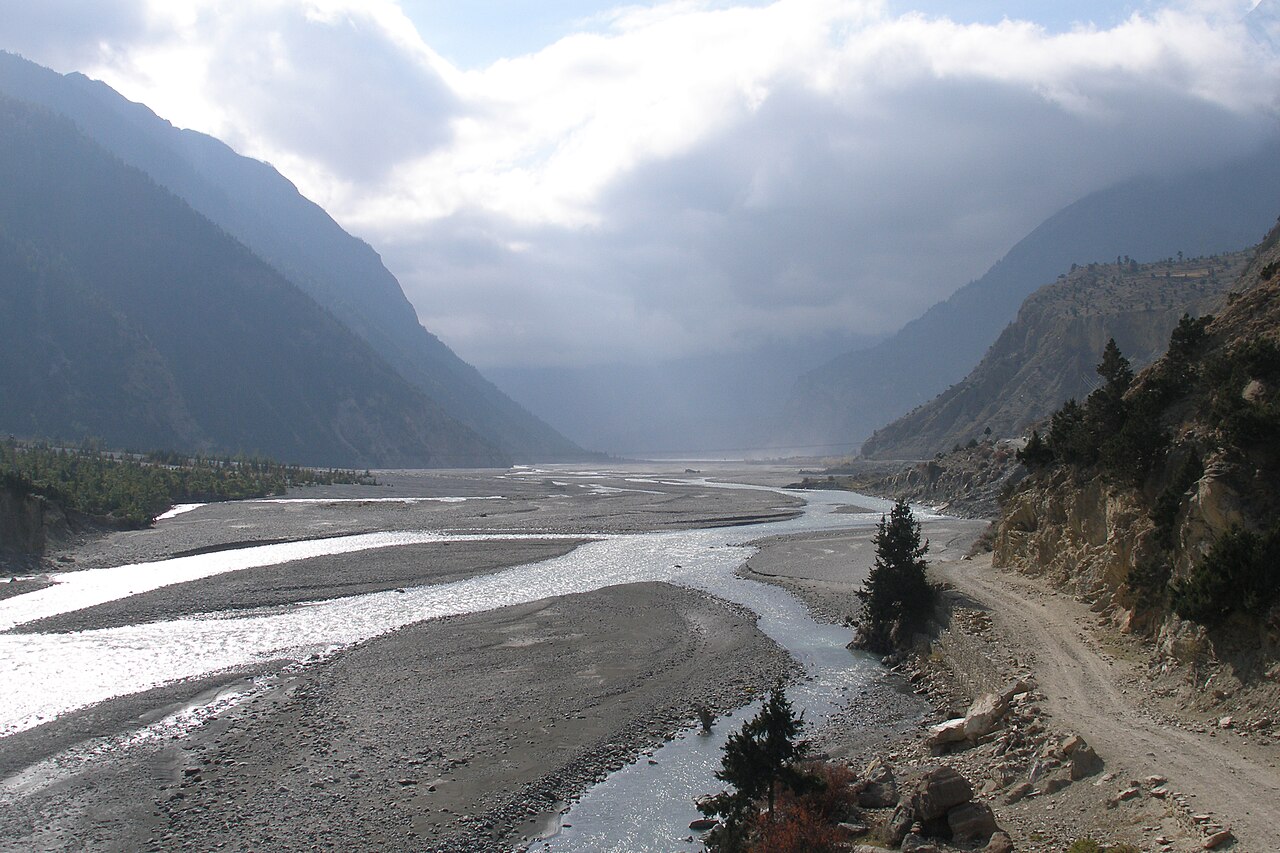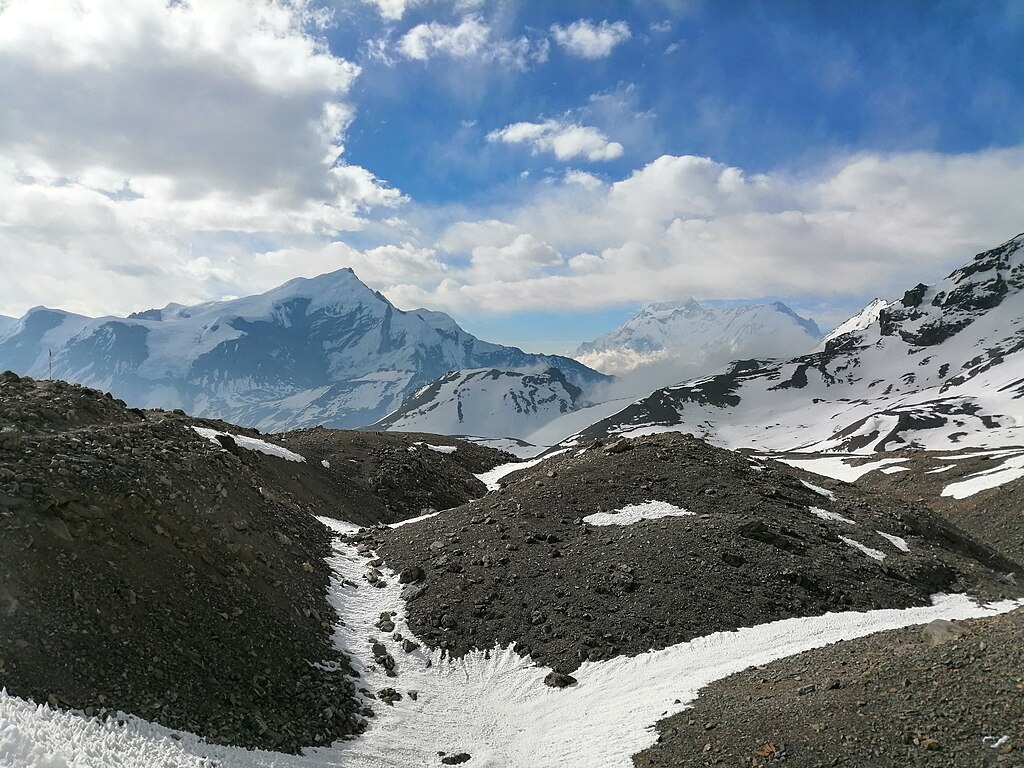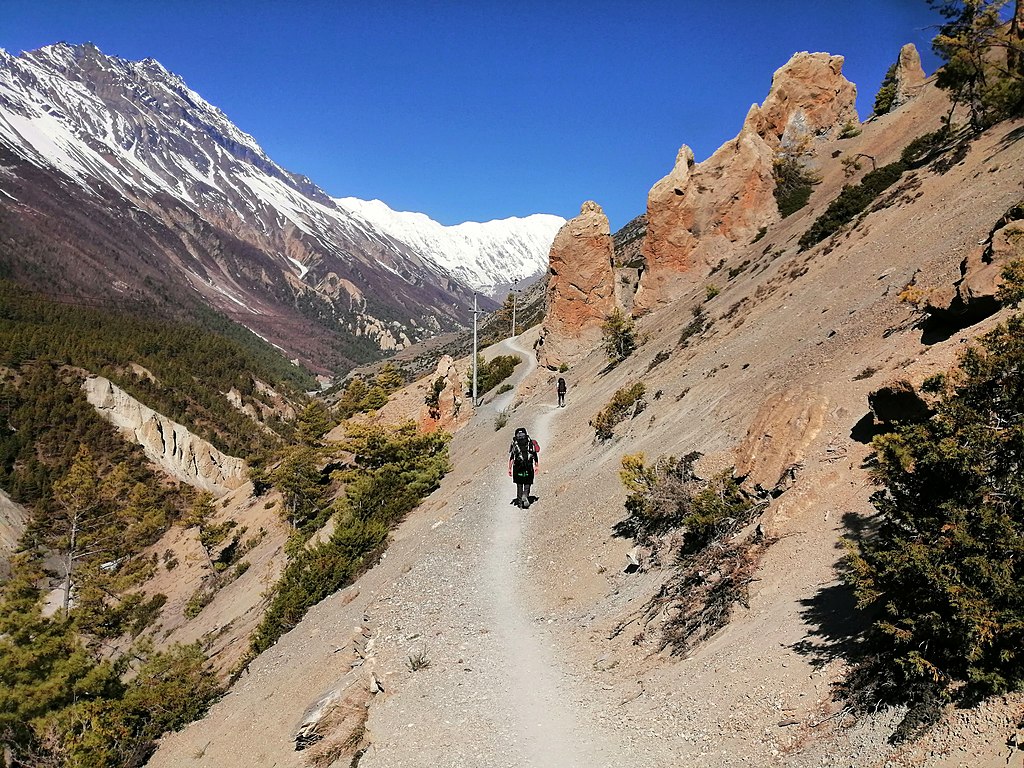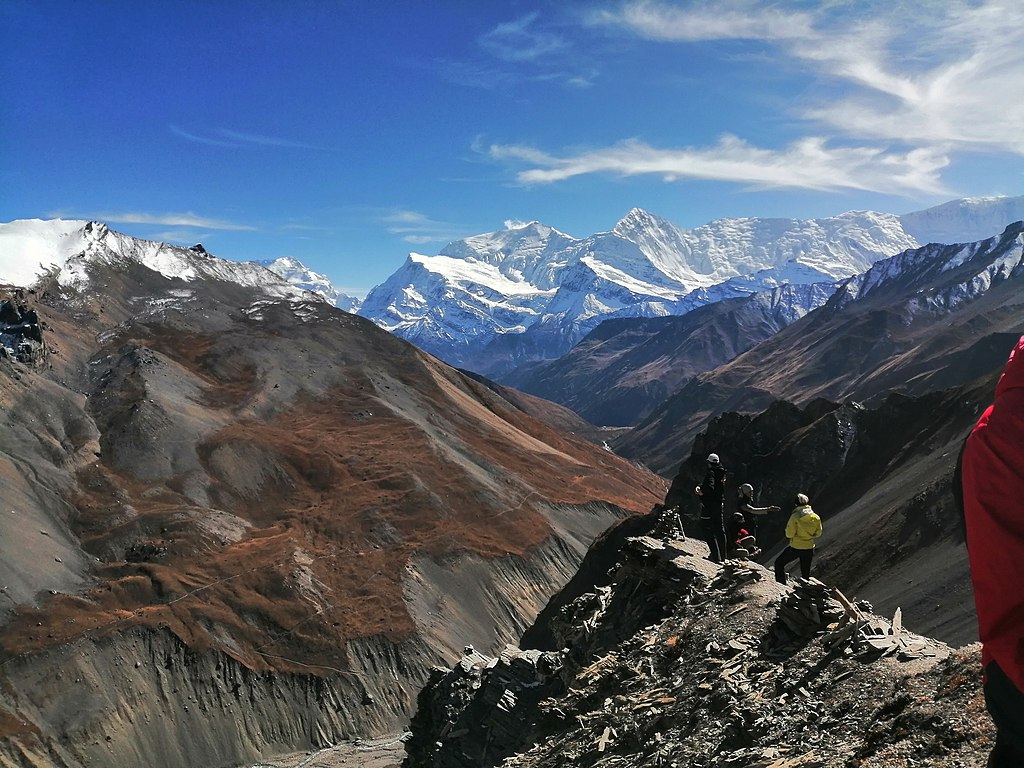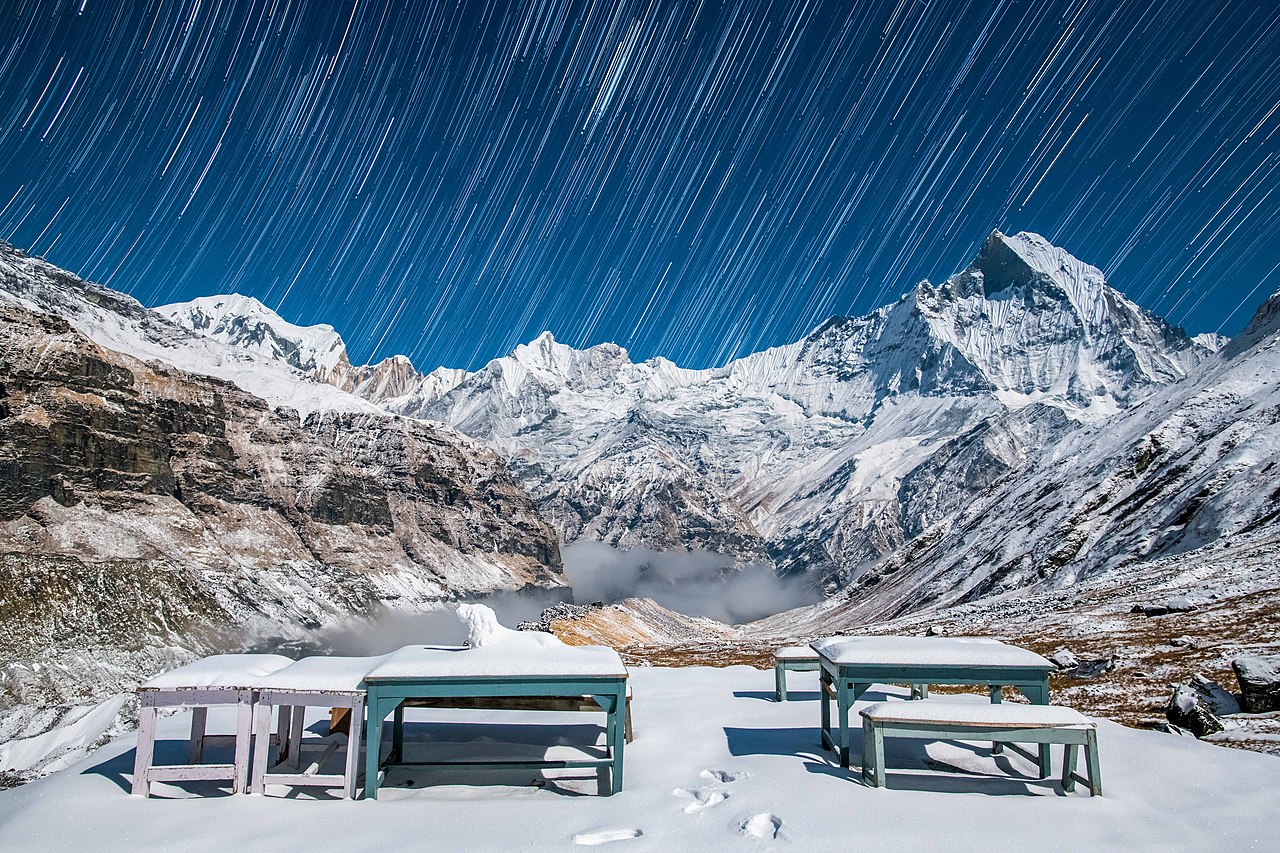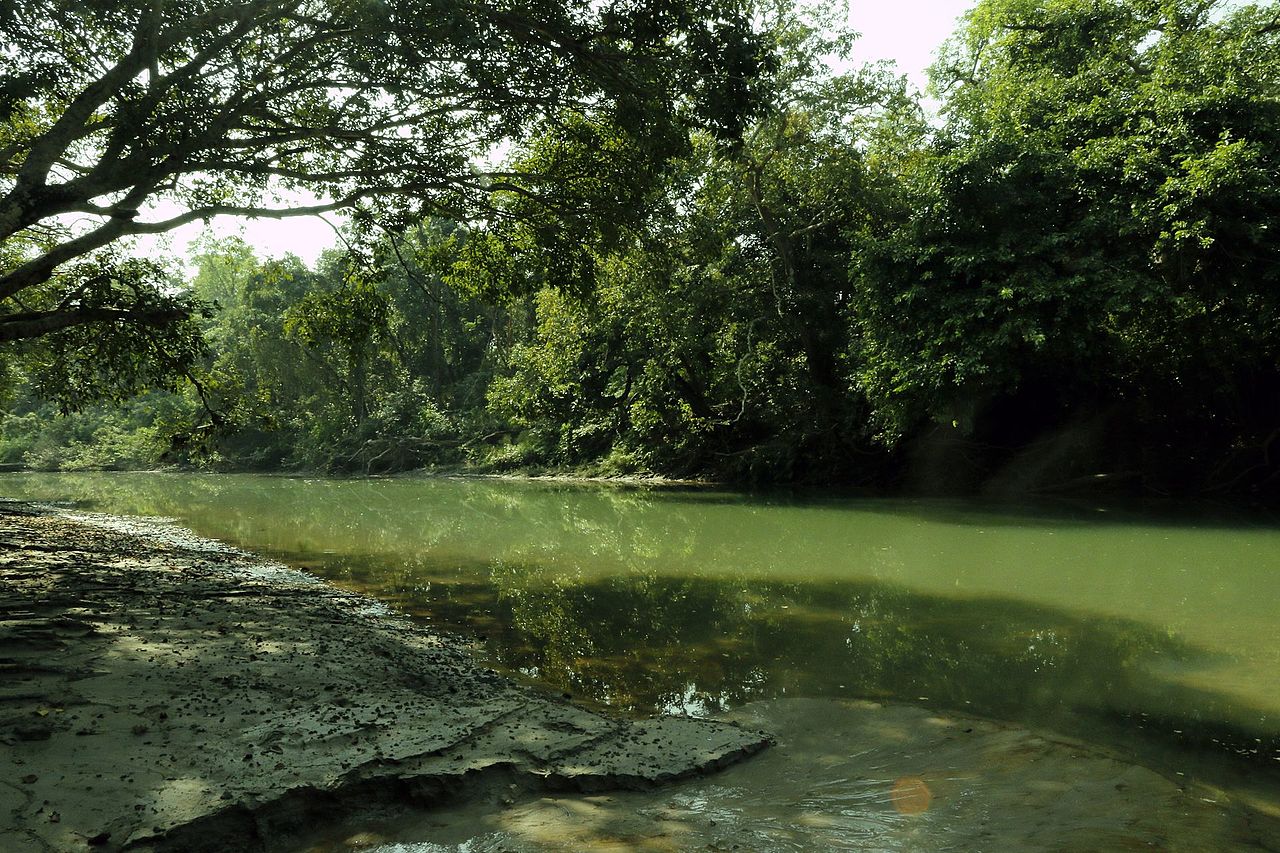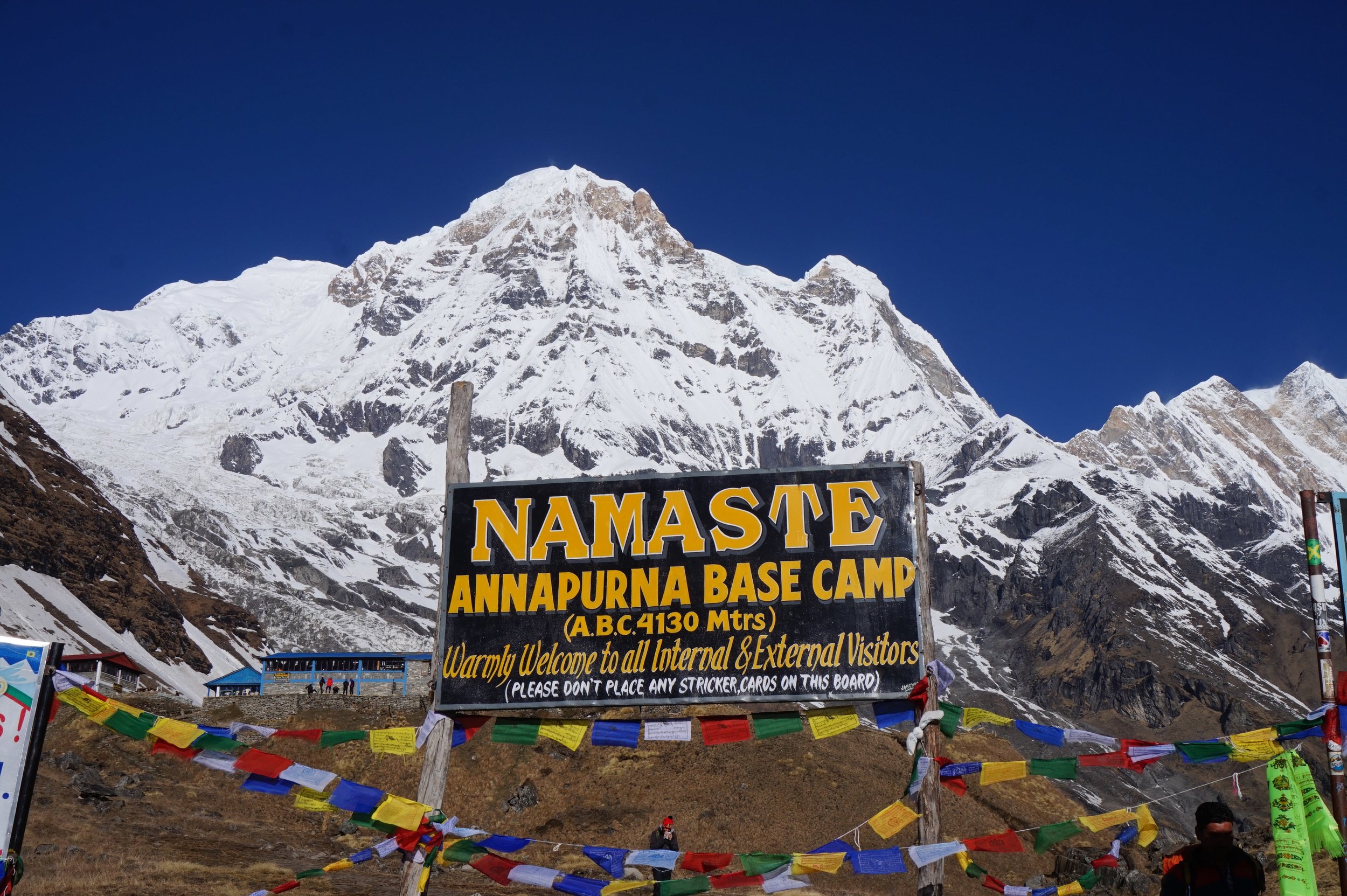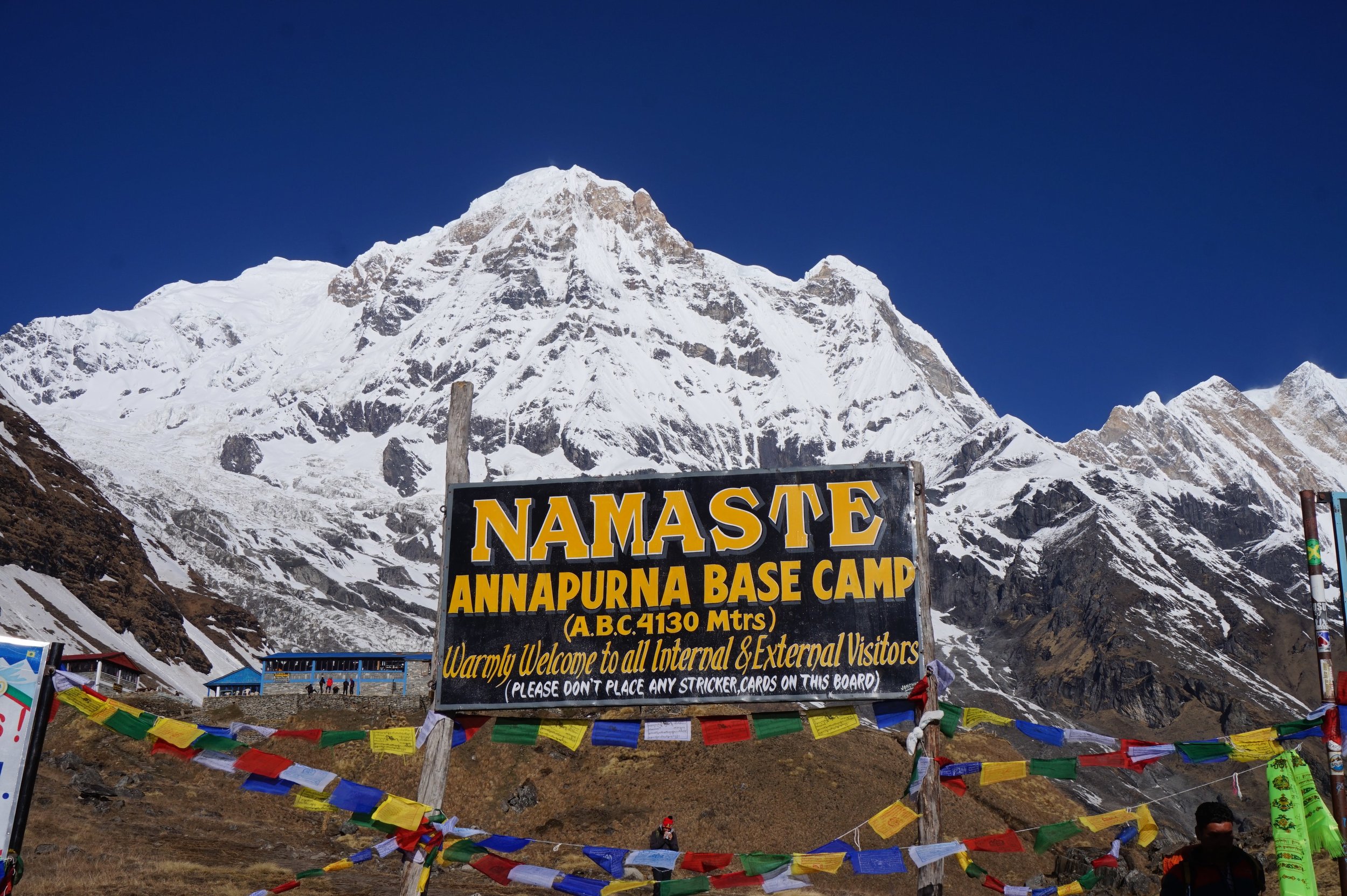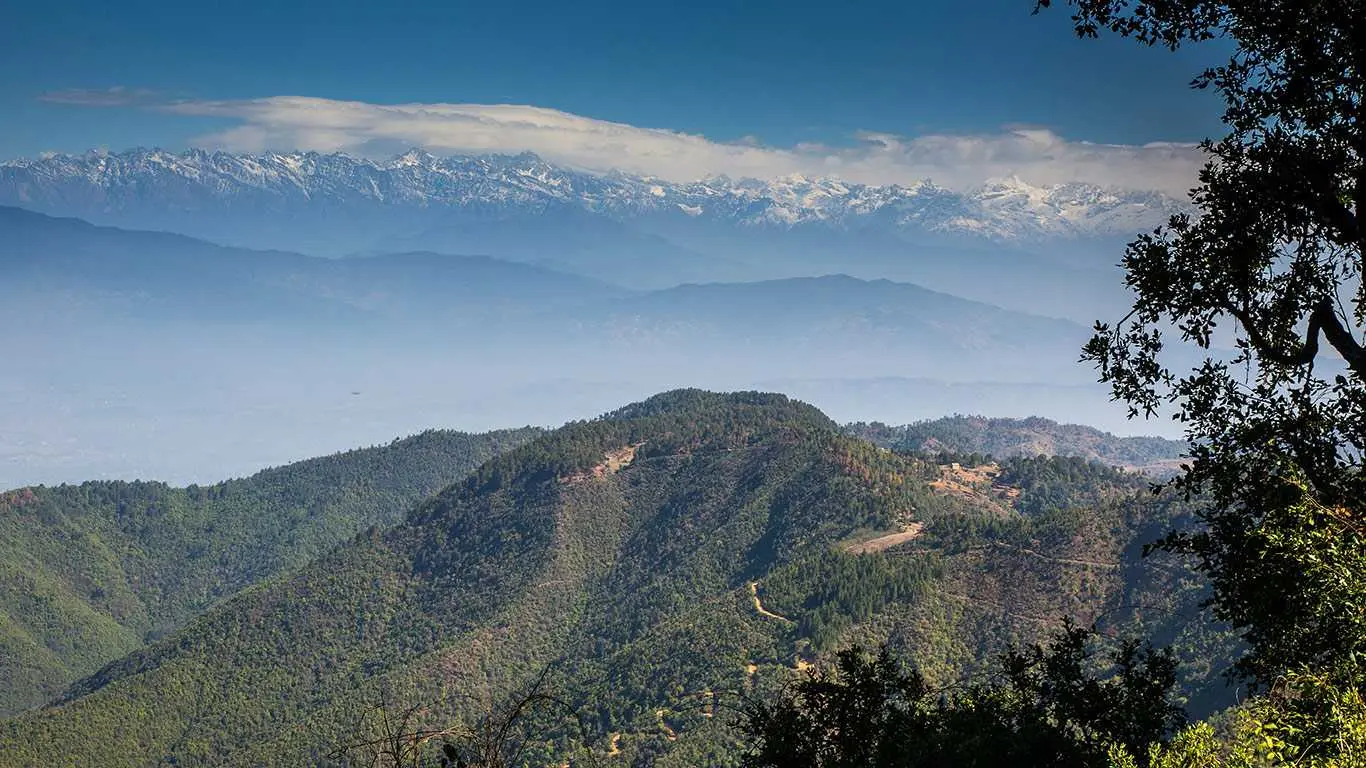15 Days Annapurna Circuit Trek
 Destination:
Nepal
Destination:
Nepal
 Trip Difficulty:
Easy
Trip Difficulty:
Easy
 Trip Style:
Tea House Lodge Trek
Trip Style:
Tea House Lodge Trek
 Food:
Breakfast+Lunch+Dinner
Food:
Breakfast+Lunch+Dinner
 Accomodation:
Tea House , Lodge
Accomodation:
Tea House , Lodge
 Group Size:
1
Group Size:
1
 Max Elevation:
5416m
Max Elevation:
5416m
 Transport:
Private Vehicle / Tourist Bus
Transport:
Private Vehicle / Tourist Bus
 Trip Price:
950$
Trip Price:
950$
 Best Time:
Feb to June and Sep to Dec
Best Time:
Feb to June and Sep to Dec
The Annapurna circuit has been voted the best long-distance trek in the world. The total length of the route varies between 160 and 230 km, depending on the transportation used. The trek crosses two different river valleys, the Kali Gandaki and Marshyangdi river valleys. This Circuit holds the highest point of 5416m at Thorung La Pass which reaches the edge of the Tibetan Plateau and then descends into Kali Gandaki -the deepest gorge in the world 5571m. Most trekkers hike the route anticlockwise assuming that the daily altitude gain is slower which will help them to conquer Thorang la pass easier and safer.
This Circuit surprises you with the majestic mountain scenery, consisting of Annapurna Massif (Annapurna I-IV), Dhaulagiri, Machhapuchhre, Manaslu, Gangapurna, Tilicho Peak, Pisang Peak, and Paungda Danda. Numerous other peaks of 6000-8000m in elevation rise from the Annapurna range.
Trekking around Annapurna is more than just a mere adventure for veterans or amateur trekkers, the best part of what trekking offers is that the experienced and the novice are combined in one perfect package – overwhelming chills at high altitudes and magnificent scenery. Customized itineraries that complement the varying speeds and preferences of the trekkers can be arranged for a 10 to 12-day trip to explore this glorious terrain, where we stop for a moment to find solace in every location passed along the way and enjoy it fully.
Annapurna circuit trek can be customized as below :
Annapurna Circuit Trek with Tilicho Lake
Annapurna Circuit Trek with Manasalu and tsum valley (28 days)
Annapurna Circuit valley with Narphu valley
Annapurna Circuit Trek with Upper Mustang
Annapurna Circuit Trek with Poon Hill
Challenges/Difficulty :
The Annapurna Circuit trek is a challenging but rewarding trek that takes you through some of the most stunning scenery in the world. The trek is considered to be moderately difficult, but there are a number of factors that can make it more or less challenging for individual trekkers.
The Annapurna Circuit trek is a long trek, covering a total distance of around 160-210km depending on the route you take. The trek typically takes 2-3 weeks to complete, and you can expect to walk for 5-6 hours each day. The terrain is varied, with some sections being relatively flat and others being quite steep. There are also a number of high-altitude passes that you will need to cross, the highest of which is Thorong La Pass at 5,416m.
The biggest challenge of the Annapurna Circuit trek is the altitude. The trek starts at a relatively low altitude, but it quickly gains altitude as you head towards the mountains. This can make it difficult for some people to acclimatize, and altitude sickness is a real risk. It is important to take your time and ascend gradually to allow your body to adjust to the thinner air.
Other challenges that you may face on the Annapurna Circuit trek include:
The weather: The weather in the Himalayas can be unpredictable, and you may experience everything from sunshine to snow. It is important to be prepared for all types of weather conditions.
The food: The food on the Annapurna Circuit trek is typically simple and basic. If you have any dietary restrictions, it is important to be prepared to eat simple meals.
The accommodation: Accommodation on the Annapurna Circuit trek is basic, and you can expect to stay in teahouses or guesthouses. These are often crowded, and the facilities are basic.
Overall, the Annapurna Circuit trek is a challenging but rewarding trek. It is important to be prepared for the challenges that you may face, but if you are up for the challenge, it is an experience that you will never forget.
Food on the Annapurna Circuit Trek
The food available on the Annapurna Circuit Trek is a mix of Nepali and international dishes, with a focus on hearty and filling options to fuel trekkers. Here's a breakdown of what you can expect:
Nepali Cuisine:
Dal Bhat: This staple Nepali dish consists of lentil soup, rice, and a variety of curries and vegetables. It's a nutritious and filling meal that's readily available in most teahouses.
Momo: These steamed or fried dumplings filled with vegetables or meat are a popular snack or appetizer.
Thukpa: This Tibetan noodle soup is a warm and comforting option, especially on colder days
Sel Roti: This sweet fried bread is a traditional Newari dish that's often served for breakfast.
International Cuisine:
Pasta: A variety of pasta dishes, such as spaghetti, macaroni, and penne, are available with different sauces.
Noodles: Chow mein and fried rice are popular options for a quick and easy meal.
Pizza: While not always authentic, pizza can be a welcome change from Nepali food.
Sandwiches: Simple sandwiches with fillings like cheese, ham, or vegetables are available at some teahouses.
Snacks and Treats:
Snacks: Energy bars, chocolate bars, cookies, nuts, and dried fruits are readily available at teahouses and small shops along the trail.
Desserts: Apple pie, pancakes, and other sweet treats are often available for a post-dinner treat.
Dietary Considerations:
Vegetarian and Vegan Options: Most teahouses offer vegetarian and vegan options, such as vegetable curries, dal bhat, and vegetable momos.
Dietary Restrictions: If you have any specific dietary restrictions, it's important to communicate them to the teahouse staff in advance. While not all teahouses can accommodate every dietary need, they will do their best to provide suitable options.
Accommodation on the Annapurna Circuit Trek
Accommodation on the Annapurna Circuit Trek primarily consists of teahouses and lodges. These range from basic guesthouses with shared rooms and bathrooms to more comfortable lodges with private rooms and en-suite bathrooms. Here's what you can expect:
Teahouses:
Shared Rooms: Most teahouses offer shared rooms with bunk beds, typically accommodating 4-6 people.
Basic Amenities: Basic amenities like blankets and pillows are usually provided.
Shared Bathrooms: Bathrooms are typically shared and may not always be clean or well-maintained.
Limited Privacy: Shared rooms can be noisy and lack privacy.
Affordable: Teahouses are the most budget-friendly accommodation option.
Lodges:
Private Rooms: Some lodges offer private rooms with en-suite bathrooms, providing more privacy and comfort.
Additional Amenities: Some lodges may offer additional amenities like hot showers, electricity, and Wi-Fi.
More Expensive: Lodges are generally more expensive than teahouses.
Other Accommodation Options:
Camping: Camping is an option for those who prefer to be self-sufficient and enjoy the outdoors. However, camping permits are required and camping is only allowed in designated areas.
Luxury Lodges: A few luxury lodges are available along the Annapurna Circuit, offering high-end amenities and services. However, these are significantly more expensive than standard teahouses and lodges.
Choosing Accommodation:
Budget: Consider your budget when choosing accommodation. Teahouses are the most affordable option, while lodges and luxury lodges are more expensive.
Comfort: If you prioritize comfort and privacy, consider staying in a lodge with a private room.
Availability: Accommodation can fill up quickly, especially during peak season. It's advisable to book your accommodation in advance, especially if you're traveling during peak season.
By understanding the food and accommodation options available on the Annapurna Circuit Trek, you can make informed decisions and ensure a comfortable and enjoyable trekking experience.
Drinking Water
Water is the most important beverage to have while trekking. One should consume 4 liters or more water daily in order to stay hydrated as there’s more water loss in the form of sweat while hiking. Staying hydrated with water helps you fight altitude sickness and adjust better to the increasing altitude every day.
You won't find any drinking water supply on the trails because of their remote location. Locals rely on natural water sources like rivers and springs, which are unsafe for tourists to drink directly. Thus, the tea shops heat up water and offer it to their customers. While the tea house where you stay provides free boiled water, you will need to pay a small fee of $1 or $2 at the tea shops located along the route for a liter of boiling water. You can further clean boiling water by adding a purifying liquid or tablets if you're still not sure if it's safe. Carrying a water bottle with a built-in filtration system and filtering the water from natural sources along the trail is the best solution.
You can also purchase bottled water for $1 to $2, although we strongly discourage using single-use plastic bottles on the path due to the growing amount of plastic debris in the Annapurna trails.
Annapurna Circuit Trek Required Permits and Fees
To begin the Anapurna Circuit Trek, trekkers need to have their permits that have been issued and alternative fees paid. Trekkers will obtain permission through ACAP and TIMS. ACAP strives to keep the natural splendor and cultural patrimony of the Annarpatina area while empowering the trekkers with the TIMS card for safety assurance. The fees for these permits vary with the national chit occurring per several seasons and the rates are adjustable, especially during the off-season. The purpose of this permit is not only to legally let trekkers use the Annapurna Circuit Route but also to minimize the impact of travelers in these ecologically fragile areas and to conserve these areas to be utilized by future generations.
Annapurna Circuit Trek Permit Costs
| ACAP Per Person | TIMS Per Person | |
|---|---|---|
| Foreign Nationals | NPR 3000 | NPR 2000 |
| SAARC Nationals | NPR 1000 | NPR 1000 |
| Nepali Citizens | Non-applicable | Non-applicable |
Guides and Porters during the Annapurna Circuit Trek
Regarding high-altitude adventure in the Annapurna region of Nepal, trekking along the Annapurna Circuit cannot be overlooked; strategic organization is always in the spotlight, while the guidance of seasoned personnel is indispensable. Appropriately choosing the right guide with previous experience and porter is vital for safe travel and a successful Annapurna trek. As a company, we offer adventure and professional guides along with porters for the Annapurna Circuit Route Trek, which becomes the base for trekkers to ascend toward high altitudes without any stress, thus allowing them to accomplish their planned trek.
In that, through years of studying the Annapurna Ranges, our team of "topnotch" guides and porters has developed a great experience with the trail and local terrain. They know how to help you in your specific situation, though they are usually there to provide you with knowledge. They can enrich the trip with their experience and skills that will leave you with a most memorable hike, from preparing tasty meals and snacks that delve into local cuisines to applying first aid and keeping an eye on safety. Our team is dedicated to continuing this work to better the experience of our trekkers day and night.
Besides the bird's eye view guiding services, we also allow trekkers in their vehicle rental services, which are different from other rental vehicle services because trekkers require unique rental vehicles for the Annapurna Circuit Trek. By maintaining our transport fleet in good condition and employing experienced drivers acquainted with mountain peaks and curve-ridden roads, we strive to provide a safe and convenient delivery service for trekkers, eliminating the hassle and lateness. We will be your companion on the hike to the Annapurna circuit or by exploring other Himalayan treasures in Nepal.
Our company strives to ensure the traveler's safety, skilled guidance, and unique hospitality to make it a trekking experience unrivaled in its caliber.
Note: A porter will be provided for each of the two Trekkers.
Qualities to Consider When Hiring a Guide and Porter
Choosing the Annapurna Circuit Trek guide who meets all the qualifications is paramount to having a safe and amazing trip. Thus, we offer guides and porters who are excellent in the following areas.
-
Government-licensed professionalism: Prefer a guide who is licensed by the government. Their permit proves they adhere to the sector's standards and regulations.
-
Extensive trekking experience: Identify guides who have previously taken hikers around the Anapurna Circuit; therefore, they are deficient in difficulty levels.
-
Comprehensive knowledge of routes and local culture: Select a representative who is fluent both with the climbing routes and with the local cultural heritage and the traditions related to the people of the communities that lie across the track.
-
Understanding local history and mythology: Find people who can tell dumb tales and funny incidents about the sites and villages along the trek and do them justice by making them sound interesting.
-
Seasonal expertise: The rider should have a guide aware of seasonal changes and the possibility of sudden difficulties along the way. This will allow the rider to adapt and prepare to face those changes.
-
Proficiency in trail navigation: Make certain that your guide is skillful in leading you through all the Annapurna Circuit trial networks, which does not lead you to get lost on the wrong track.
-
First-aid training: Prefer guides who are qualified for first aid and prepared for any medical emergencies that could occur on the trek. The main focus will be on rescuing trekkers.
-
Emergency response experience: Select tour guides who are experts in handling emergencies, prove their capabilities to stay cool-headed amid unexpected challenges, and take adequate and effective measures when stuck in an emergency.
Some Qualities to Look for When Hiring Porters for the Annapurna Circuit Trek:
-
Ability to carry heavy loads: It's important to find porters who demonstrate strong muscles and stamina and can bear any weight between 20 and 25 kilograms, which could encompass backpacks and equipment since they will be shouldering the luggage.
-
Capacity to handle multiple clients: Allocate the workload that each porter shall handle with the amount of 2 clients' bags to ensure that the porter is not overburdened and that efficient group trekking is guaranteed.
- Helpful and sincere demeanor: Proficiency in English may not be a prerequisite, resort to hiring porters who display an excellently communicative and caring attitude, for them to be the positive segments through which your customers get to enjoy their trips fully from their sincere and helpful nature.
-
Strong people-handling skills: Look for guides with finesse in handling people. This is mostly needed at the Circuit Trek to Annapurna because the guide is required to be effective at tasks like accommodating clients' luggage and ensuring that they are as comfortable and safe as possible throughout the journey.
-
Familiarity with local language and culture: Consider using porters who may communicate in the local languages and are conversant with local customs. The individuals will have a vital role in acting as intermediaries between the visitors and the locals, facilitating smooth communication and interaction between the two groups. Thus, the cultural exchange will be enhanced, and communication among the other members will be effective.
-
Qualifications and experience: Stress that the trekkers must hire licensed and experienced porters for the Annapurna Circuit Trek since they know the path well and are positively experienced, which can ensure a safe and successful journey for you.
By focusing on the essential aspects of competency and reliability while hiring porters for the Annapurna Circuit trail, trekkers can be highly entertained and enjoy majestic views of the Himalayas in the company of useful ones.
Best Time for a Round Trek for Annapurna
The Annapurna Circuit trek turns out to be an adventurous trip through the scenic Annapurna region, and the number of seasons is a very determining factor for the quality of the experience. It has been known by trekkers that Spring is their preferred season for trekking due to fair weather and magnificent flower blooming which usually lasts for three months from March through May. On the way, they find rhododendron-covered trails that make the scenery of the trekking route even more incredible. For mild temperatures, clear skies, and monsoon rains, the trekking is enjoyable and safe, while the local cultural festival in the area enhances the knowledge of the traditions and customs.
The autumn journey of the Annapurna Circuit is another best season that might as well be considered while planning the trek. Here, trekkers get fresh air, clear skies, and moderate temperatures, making this time perfect for them to conquer the circuit trek, which is rough. The non-existence of monsoon rains reduces the risk of landslides, thus making the trail conditions safer for trekkers. The autumn landscape is also decorated with colorful leaves of red, yellow, brown, and orange, which enhance the beauty of the Annapurna range even more and offer excellent views of the scenery and the surrounding peaks.
Spring and autumn are amazing for trekkers who want to get deep into the Annapurna region's unknown nature and vivid culture. By undertaking the circuit trail during the period of colorful spring bloom or at the time of the incredible display of autumn leaves, each season gives you a new and memorable trekking experience. The trekkers find comfort and friendship in the tea houses scattered along the trails, where they can rest well and enjoy Nepalese people's hospitality. After all, whatever the chosen season for the Annapurna Circuit trek will turn into a transforming experience, encountering wonderful landscapes and cultural encounters and keeping in your memory hiking this iconic trail circuit path.
Detail Itinerary
Day 01 Arrival in Kathmandu (1350 m) Special Welcome Dinner
Upon your arrival at Tribhuvan International Airport, members of the Nepal Adventure Team will warmly welcome you and facilitate your transfer to one of the cozy hotels nestled in Thamel, Kathmandu's vibrant tourist district. Following a chance to refresh and rejuvenate, our seasoned trek operator will provide a comprehensive briefing, covering essential aspects such as accommodation details, insights into Nepali culture, proposed tours, and the thrilling Annapurna Circuit Trekking adventure that awaits. Additionally, you'll be treated to a delightful welcome dinner at a quintessential Nepalese restaurant, where you can savor traditional cuisine amidst the captivating ambiance of a folk cultural performance, setting the perfect tone for your upcoming journey into the heart of Nepal's natural wonders.
 Meals:
Breakfast/Lunch/Dinner
Meals:
Breakfast/Lunch/Dinner
 Accommodation:
3 star hotel
Accommodation:
3 star hotel
 Max. Altitude:
1350m
Max. Altitude:
1350m
 Place:
kathmandu
Place:
kathmandu
Embarking on a picturesque journey through the heart of Nepal, your route unfolds with each winding road, revealing breathtaking vistas that stretch as far as the eye can see. The drive leads you towards the tranquil mid-western region, where the landscape transitions from bustling cityscapes to serene countryside. As dusk begins to descend, you find yourself arriving at the charming town of Besisahar, nestled amidst verdant hills and flowing rivers. Here, you will spend the first night of your journey, immersing yourself in the warmth of Nepalese hospitality and preparing for the adventures that await in the days ahead. With the promise of new experiences on the horizon, Besisahar beckons as a tranquil haven amidst the grandeur of Nepal's natural beauty.
 Meals:
breakfast/Lunch/Dinner
Meals:
breakfast/Lunch/Dinner
 Accommodation:
Tea house Lodge
Accommodation:
Tea house Lodge
 Max. Altitude:
800m
Max. Altitude:
800m
 Place:
Pokhara
Place:
Pokhara
After enjoying a hearty breakfast at the Guest House in Bensisahar, we will embark on a scenic journey towards Chame, a drive that promises approximately 7 to 8 hours of breathtaking views and thrilling twists through the rugged terrain. As we navigate the winding roads, each bend unveils new panoramas of the majestic Himalayas, lush valleys, and quaint villages. Upon reaching Chame, we settle into the cozy comfort of the Tea House Lodge, where warm hospitality awaits. Here, amidst the serene ambiance, we look forward to a restful overnight stay, rejuvenating our spirits for the adventures that lie ahead on our Himalayan expedition.
 Meals:
Breakfast/Lunch/Dinner
Meals:
Breakfast/Lunch/Dinner
 Accommodation:
Tea house Lodge
Accommodation:
Tea house Lodge
 Max. Altitude:
2740
Max. Altitude:
2740
 Place:
chame
Place:
chame
The journey through the enchanting alpine forests of rhododendrons and pine trees, tracing the meandering path alongside the Marshyangdi River, unveils a picturesque route punctuated by gentle undulations. As the trail leads to Bhratang village, the landscape transitions, offering a serene ambiance. From there, the journey ascends through alpine woodlands to Dhukure Pokhari, a quaint locale adorned with a handful of teahouses and a lodge offering mesmerizing views of Chulu’s and Pisang peaks. A brief respite and lunch break here rejuvenates weary travelers before the descent to lower Pisang village for an overnight stay, where the tranquility of the surroundings promises a peaceful rest amidst the embrace of the Himalayan wilderness.
 Meals:
Breakfast/Lunch/Dinner
Meals:
Breakfast/Lunch/Dinner
 Accommodation:
Tea house Lodge
Accommodation:
Tea house Lodge
 Max. Altitude:
3230
Max. Altitude:
3230
 Place:
pisang
Place:
pisang
Pisang village offers great scenery of mountains and surrounding landscapes. From here, altitude gains as a short uphill climb begins with super views of staggering Annapurna II and III, Gangapurna, Chulu’s, and Pisang Peak. As you reach the flat valley of Hongde village, tree lines disappear, and barren and arid landscapes with cold, dry arctic climates are experienced. We visit the old Braga monastery with old Buddhist relics, ancient wall paintings, and stunning views of Annapurna Himalaya. Manang village is accomplished after an hour's walk where we have a warm night stay.
 Meals:
Breakfast/Lunch/Dinner
Meals:
Breakfast/Lunch/Dinner
 Accommodation:
Tea house Lodge
Accommodation:
Tea house Lodge
 Max. Altitude:
3519
Max. Altitude:
3519
 Place:
Manang Village
Place:
Manang Village
In preparation for the challenging ascent to Thorang-La pass, a day of acclimatization is wisely set aside, allowing trekkers to adjust to the higher elevations. Amidst this crucial period, an optional short hike presents an enticing opportunity to explore the picturesque village of Manang. Nestled within a windswept valley, Manang boasts a commanding presence along the banks of the Marsyangdi River, with the majestic Annapurna and Gangapurna mountain ranges providing a breathtaking backdrop. As one ventures on the nearby trails, vistas unfold, revealing the awe-inspiring Gangapurna Glacier and the tranquil Manang emerald Lake, casting a spellbinding charm over the landscape and offering a taste of the natural wonders awaiting beyond the village confines.
 Meals:
Breakfast/Lunch/Dinner
Meals:
Breakfast/Lunch/Dinner
 Accommodation:
Tea house Lodge
Accommodation:
Tea house Lodge
 Max. Altitude:
3519
Max. Altitude:
3519
 Place:
Manang Village
Place:
Manang Village
After a day of rest, rejuvenated and eager for adventure, we embarked on our trek to Ghunsang village, ascending along the uphill path towards Yak Kharka. The high altitude journey treated us to breathtaking vistas of majestic snowcapped mountains, painting a picture-perfect backdrop against the clear blue sky. Traversing across a gentle stream, we arrived at the quaint settlement of Yak Kharka, nestled amidst the rugged terrain. Despite its modest size, the village offered unparalleled panoramic views of towering peaks such as Gangapurna, Annapurna III, and the awe-inspiring Chulu Peaks, providing us with a serene and memorable retreat for the night.
 Meals:
Breakfast/Lunch/Dinner
Meals:
Breakfast/Lunch/Dinner
 Accommodation:
Tea house Lodge
Accommodation:
Tea house Lodge
 Max. Altitude:
4110
Max. Altitude:
4110
 Place:
Yak Kharka
Place:
Yak Kharka
The trek reaches its zenith as we ascend towards Thorong-La Base, a pivotal point in our journey. Traversing a bridge and ascending along the picturesque river bank of Jarjung, we eventually arrive at Thorong Phedi. Here, we assess the physical well-being of our clients, determining the next course of action. For those ready and able, we press on towards Thorong High Camp, where we settle for the night, preparing both physically and mentally for the challenges that lie ahead on this awe-inspiring trek.
 Meals:
Breakfast/Lunch/Dinner
Meals:
Breakfast/Lunch/Dinner
 Accommodation:
Tea house Lodge
Accommodation:
Tea house Lodge
 Max. Altitude:
4880m
Max. Altitude:
4880m
 Place:
Thorong la base
Place:
Thorong la base
The 9th day of our trek marks a pivotal moment as we confront the formidable challenge of Thorang-La Pass, standing tall at 5,416 meters above sea level. Fueled by a hearty breakfast, we muster our collective strength to tackle the steep and winding ascent. This arduous journey demands not only physical endurance but also unwavering determination. Yet, the reward at the summit is unparalleled—a breathtaking panorama of majestic landscapes adorned with glistening snow-capped peaks. As we descend from this lofty height, our path leads us to Muktinath at 3,800 meters, a sacred site revered by both Hindus and Buddhists alike. Known as 'the place for Nirvana or Liberation,' Muktinath beckons pilgrims with its spiritual aura, offering a profound sense of fulfillment amidst the rugged beauty of the Himalayas.
 Meals:
Breakfast/Lunch/Dinner
Meals:
Breakfast/Lunch/Dinner
 Accommodation:
Tea house Lodge
Accommodation:
Tea house Lodge
 Max. Altitude:
3800m
Max. Altitude:
3800m
 Place:
Muktinath
Place:
Muktinath
After the serene sojourn at Muktinath, the remainder of the journey unfolds with more manageable trails, offering respite to weary travelers. Descending towards the Kaligandaki River valley at 1,200 meters, the trek leads through picturesque landscapes marked by moderate walks. Along the route lies Jomsom, serving as the administrative center of the Mustang district, boasting a modest airstrip overlooking the Kaligandaki River. En route, one encounters the charming Marpha village, inhabited by the Thakali community renowned for its rich cultural heritage and flourishing apple orchards. Here, amidst the tranquil ambiance, travelers indulge in the renowned local apple products – be it the refreshing cider, the warm brandy, or the pure juice, celebrating the journey with flavors unique to the region.
 Meals:
Breakfast/Lunch/Dinner
Meals:
Breakfast/Lunch/Dinner
 Accommodation:
Tea house Lodge
Accommodation:
Tea house Lodge
 Max. Altitude:
2715
Max. Altitude:
2715
 Place:
Jomsom
Place:
Jomsom
Lete brings a dramatic change in vegetation and landscapes from dry desert to pine and conifer forests. The first two hours of trek passes through the village of Ghasa with constant view of the snow capped peaks in between the cool forest. This pleasant walk continues amidst the high hills all the way to the village of Tatopani through the high and beautiful waterfalls of Rupsi. Tatopani (Hot Spring) is another nice village with large hot spring pools just by the bank of the River Kaligandaki. During summer and spring season, you view numerous high waterfalls throughout the trek.
 Meals:
Breakfast/Lunch/Dinner
Meals:
Breakfast/Lunch/Dinner
 Accommodation:
Tea house Lodge
Accommodation:
Tea house Lodge
 Max. Altitude:
1190m
Max. Altitude:
1190m
 Place:
Tatopani
Place:
Tatopani
After a wonderful time at Tatopani, the winding trail continues for an hour, then crosses a suspension bridge over the Kaligandaki River to arrive at the junction of two trails. Our route diverts from here to dense alpine forest reaching at Chitre. Ghorepani-Deurali is an hour away from Chitre. Ghorepani is famous for the viewpoint of Poon-Hill and its culture. It offers the magnificent scene of a mountain range whose beauty is enhanced by the golden sunrise and sunset.
 Meals:
Breakfast/Lunch/Dinner
Meals:
Breakfast/Lunch/Dinner
 Accommodation:
Tea house Lodge
Accommodation:
Tea house Lodge
 Max. Altitude:
2750m
Max. Altitude:
2750m
 Place:
Ghorepani
Place:
Ghorepani
Descending from Ghorepani to Nayapul offers a seamless transition from the rugged beauty of the Himalayas to the vibrant energy of the city. In Pokhara, a treasure trove of experiences awaits, from the majestic spectacle of mountain views to the tranquil serenity of its lakeshores. As the day fades into night, the city comes alive with a bustling nightlife, offering a plethora of options for entertainment and relaxation. Whether savoring local delicacies or enjoying a drink with the ever-accommodating Nepal Adventure Team staff, every moment in Pokhara is an invitation to celebrate the wonders of nature and the warmth of Nepalese hospitality.
 Meals:
Breakfast/Lunch/Dinner
Meals:
Breakfast/Lunch/Dinner
 Accommodation:
Hotel
Accommodation:
Hotel
 Max. Altitude:
860m
Max. Altitude:
860m
 Place:
Pokhara
Place:
Pokhara
After a rejuvenating morning journey back to Kathmandu, you'll have the entire day ahead to unwind and explore the vibrant markets at your leisure. Whether you're drawn to the colorful stalls of local artisans or crave a leisurely stroll through bustling streets, the day is yours to savor. Should the mood strike, you can enlist the guidance of your knowledgeable escort to delve deeper into the city's treasures. As evening descends, a final farewell dinner awaits, offering a chance to reflect on the adventures shared and memories made throughout your journey in Nepal.
 Meals:
Breakfast/Lunch/Dinner
Meals:
Breakfast/Lunch/Dinner
 Accommodation:
Hotel
Accommodation:
Hotel
 Max. Altitude:
1350m
Max. Altitude:
1350m
 Place:
Kathmandu
Place:
Kathmandu
After the awe-inspiring journey to Annapurna Base Camp, Nepal Adventure Team gracefully escorts you to Tribhuvan International Airport. Their dedication to ensuring your safety and enjoyment throughout the adventure shines brightly, leaving a lasting impression. As you bid farewell, with gratitude in your heart and memories etched in your mind, you depart with the hope of returning soon to embark on another unforgettable adventure with the Nepal Adventure Team.
 Meals:
Breakfast
Meals:
Breakfast
Trip Map
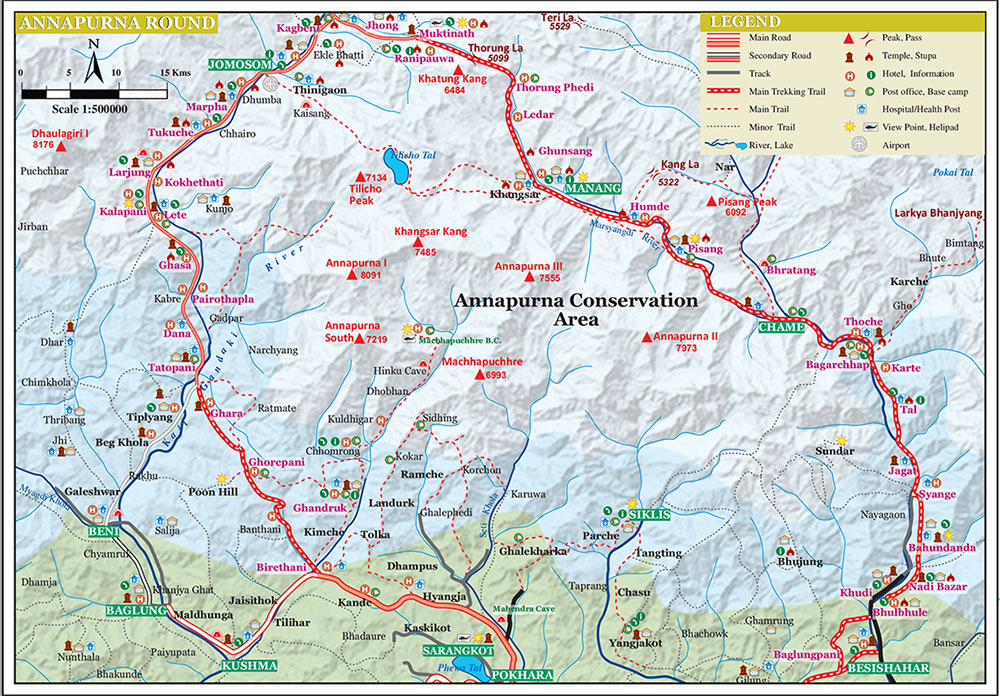
What's Included
- All airport transfer pickup and drop by private vehicles
- Welcome and farewell dinner at an authentic Nepali restaurant
- Kathmandu to Besisahar by deluxe Local Bus, and 4WD Jeep to Chame
- 2 nights hotel in Kathmandu and 1 night Hotel at Pokhara on a BB basis
- 11 nights teahouse lodge during the trek
- Breakfast, lunch, dinner, and tea/coffee in cups throughout the trek
- Experience and English-speaking trekking guide his salary, food, accommodation, equipment, and insurance.
- One strong porter, his salary, food, accommodation, equipment, and insurance
- From Nayapul to Pokhara by private vehicle
- Pokhara to Kathmandu by Deluxe Sofa tourist bus
- ACAP permit fee (Annapurna Conservation Area Project)
- TIMS card fee (Trekkers Information Management System)
- Trekking equipment like a sleeping bag and down jacket (if needed)
- Company T-shirt, appreciation letter, and trek map
- First Aid medical Kitbag
- All government VAT, and Local Taxes
What's Excluded
- Nepal visa fee and visa extension fee
- International airfare
- Extra drinks as alcoholic and non-alcoholic
- Personal expenses like chocolate, biscuits, phone bill, toilet paper, Etc.
- Travel and rescue and insurance
Additional Info
Packing List for Annapurna Circuit Trek:
Backpack: Decide on a capacious backpack to allow you to chuck in your daily necessities effortlessly.
Sleeping bag: Pay special attention to ensure you pack a warm sleeping bag for evening peaceful nights in the mountains.
Sleeping pad: A sleeping pad serves the purpose of thermal insulation as well as protecting your hips and shoulders from pain during sleep.
Clothing: Layering is key for varying weather conditions and hence, an appropriate assortment of base layers, mid-layers, and outerwear is recommended. Never leave your socks at home when you know that a change of socks is required more often.
Rain gear: Must have a waterproof jacket and pants to stay dry on wet days.
Headlamp: Hands-free headlight is a must-have gear for moving on narrow and dark trails that are set up for either morning or night time.
Trekking poles: They act as stepping stones and prevent the reliance on knees when the path is very uneven.
Hiking boots: Pick the boots that match well and are already broken into the majority of the extent for comfort and support during the hike.
Water bottle: Drink enough water throughout your hike with a durable water bottle to keep yourself refreshed and ready to tackle all terrain.
Snacks: Carry with you heaps of snacks that provide high energy such as trail mix and energy bars to stay motivated through the hike.
First aid kit: Have a small first aid kit with you that contains important items like Band-Aids, pain relievers, and blister pads.
Sun protection: To protect yourself from UV rays you need to use sunscreen, sunglasses, and a wide-horned hat.
Personal hygiene items: Brush, paste, hand sanitizer, and other hygiene goods make an essential kit with a must-mention here.
Passport: Your passport, the main instrument for your Nepal physical presence, cannot be neglected.
Travel documents: Get your flight itineraries and travel insurance plan photocopied and easy to access.
Cash: Small bills are to be kept handy for minor expenses on the way. For example, snacks last longer with coffee than those without.
Camera: Create images apart like awe-inspiring scenery, and keep the most precious of moments alive with a camera.
Altitude Sickness and Remedies During Annapurna Circuit Trek:
Throughout the Annapurna Circuit, Hike hikers undergo a major decrease in oxygen proportion and pressure as they reach higher altitudes, which are less than at sea level. With the onset of the hike, we gain elevation and then scale the highest level (5,416 meters) above sea level while departing from lower elevations. Trekkers who are at altitudes of 3000 meters or more are in danger of undergoing conventional altitude sickness symptoms, which may includenausea, diarrhea, sickness, decrease in interest to eat, fatigue, and insomnia. Determining these symptoms on time is important as missing to is dangerous even further. In the descent of a lower elevation, the symptoms can subside, however, there is a chance someone may overheat or get sick and it is often the case that individuals are cautious to report discomfort for fear of being stopped from going any further and that may even lead to one’s safety being jeopardized. It is vitally important to seek advice from your medical tour guide on the slightest signs of sickness, to assist in making early interventions.
For successful adjustment oneself to decrease the chance of encountering the symptoms of altitude sickness, is very important. The process of adaptation helps one gradually become acclimatized to the different environmental conditions, hence, enabling better adaptation. Behaviors like ensuring hydration, maintaining a moderate pace, and heeding the instruction of the veteran bunch of climbers make acute mountain sickness(AMS). Moreover, the fact that one should not drink alcohol and smoke cigarettes during the trip assists in exposure protection from mountain sickness. By considering and prioritizing safety, maintaining and assuring communication, and applying acclimatization strategies, climbers can successfully deal with the issues of altitude trekking and have the high-altitude trekking on the Annapurna Circuit safely and in pleasantness.
Early Symptoms of Altitude Sickness
- Increased breathing.
- Headache and Restless sleep.
- Increased urination.
- Dehydration.
- Periodic breathing at night as a result of altitude.
Later symptoms
- Shortness of breath.
- Respiratory failure.
- Extreme fatigue.
- Coma.
- Cerebral edema.
You can take other precautions to reduce the risk of getting altitude sickness while trekking to the Everest Base camp.
- Rise gradually and allow for acclimatization periods, e.g., resting thoroughly at a higher altitude for one day before descending to night at lower elevation levels.
- A note of caution is essential, too, as the level of oxygen decreases with elevation and the scarcity of vegetation during the EBC trek. Avoid alcohol, smoking, or other tobacco products since they worsen dehydration.
- Stay hydrated at all times by drinking warm water along the way to counter high altitude impacts.
- Psychologically prepare yourself for the journey and remain in high spirits to enrich the expedition and decrease stress.
- It is recommended not to use sleeping pills for insomnia management since they can reduce blood oxygen levels and worsen mountain sickness.
- The altitude sickness symptoms worsen, do not climb higher and go down to a lower altitude.
Reviews (0)
Customer Reviews & Ratings
0.0 / 5.0
Based On 0 Reviews
5
0
4
0
3
0
2
0
1
0
Send an Enquiry
Why Book With Us
-
✔
Expert Guides with Local Knowledge
-
✔
Personalized Itineraries and Customization
-
✔
Safety and Comfort at Every Step
-
✔
Affordable Prices with No Hidden Fees
Need Assistance?
If you have any questions about this trek, feel free to contact us. Our travel experts are happy to assist you 24/7.
Contact Us
